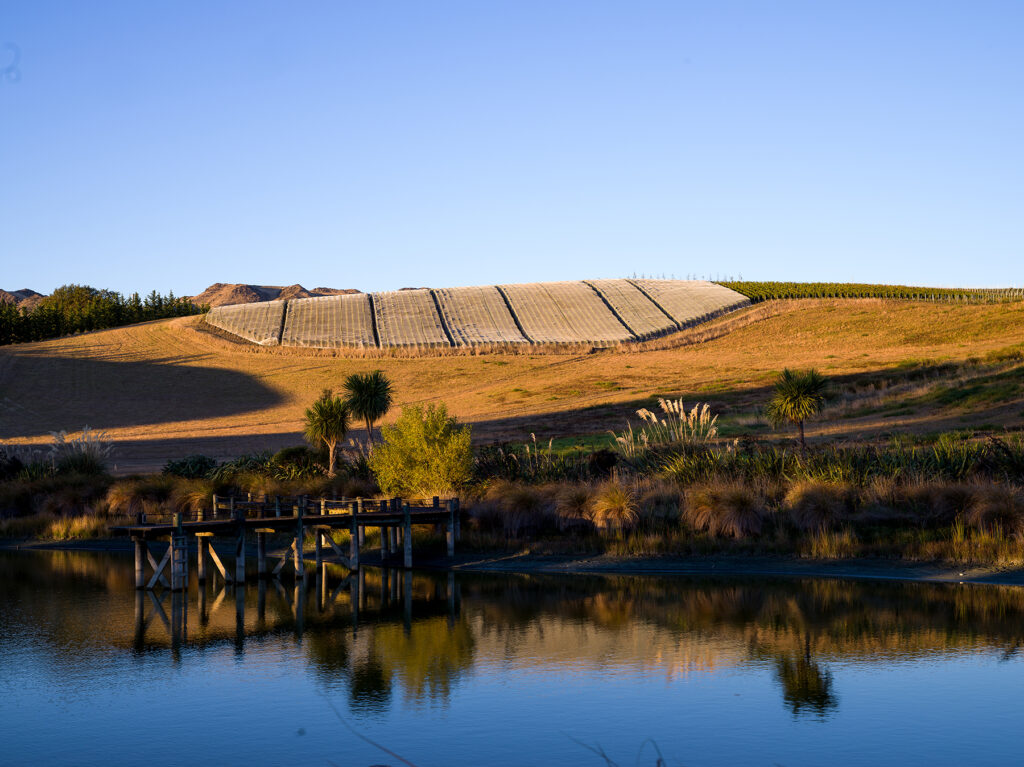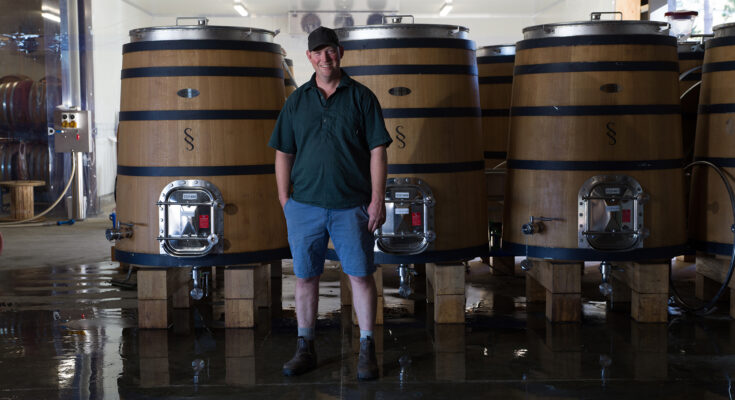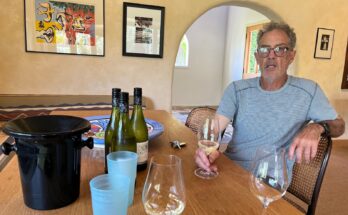I’m on my second day in North Canterbury, visiting a few of the vineyards in the area, and today is an opportunity to drop into Pyramid Valley over at Waikari. This is my first visit since the vineyard was sold by founders Claudia and Mike Weersing, and I’m here to catch up with winemaker Huw Kinch and see the latest planting and developments at this iconic site.
Huw Kinch: We’re still in the midst of things – we make a Central Otago Pinot Noir as well, so we’ve still got plenty ferments still going. We’ve finished picking but vintage doesn’t finish then, still about another eight Pinot ferments on skins. We’ve re-structured the Grower Series into an Appellation Series, focussing on North Canterbury mainly. I’ll tell you the story from the start..
Mike came to New Zealand in 1995 and worked for Neudorf, and pretty much the whole time he was working there he was on a search for a site with clay/limestone soil. He wanted to grow Pinot Noir and Chardonnay on these soils after studying and working in Burgundy. Every weekend, he’d either travel to Wellington to go to the library – because it was pre-internet – and look at soil maps, to work out where he was going the following weekend to dig up soil samples. He was sending them back to Claude and Lydia Bourgogne, famous soil scientists based in Burgundy. Fast forward a bit.. he came to this property early on, and dug higher on the hill and he found pretty much pure limestone and not much clay – so that was their feedback really. Everyone talks about the search for limestone but it was the search for clay as well. And the right type of clay. The structure of our clay is more like a honeycomb structure, so it holds water and nutrients very successfully.
Then he tells a story where he was pretty much towards the end and he was about to get on a plane, and give up. And then he thought he’d come back to this site and he dug lower on the slope, and actually found the right combo of clay and limestone. Down below where we are now in the Winery and the lower slopes there’s just pure clay and deep greensand. Not very free-draining, cracks of a couple of centimetres in summer when its dry, and a boggy mess in Winter. So not suitable for vines. Then you hit the mid-slope where the limestone joins with the clay and the soil becomes very friable and easy to dig, and free-draining. Then you get above the vineyards and that’s where you get out of the clay.
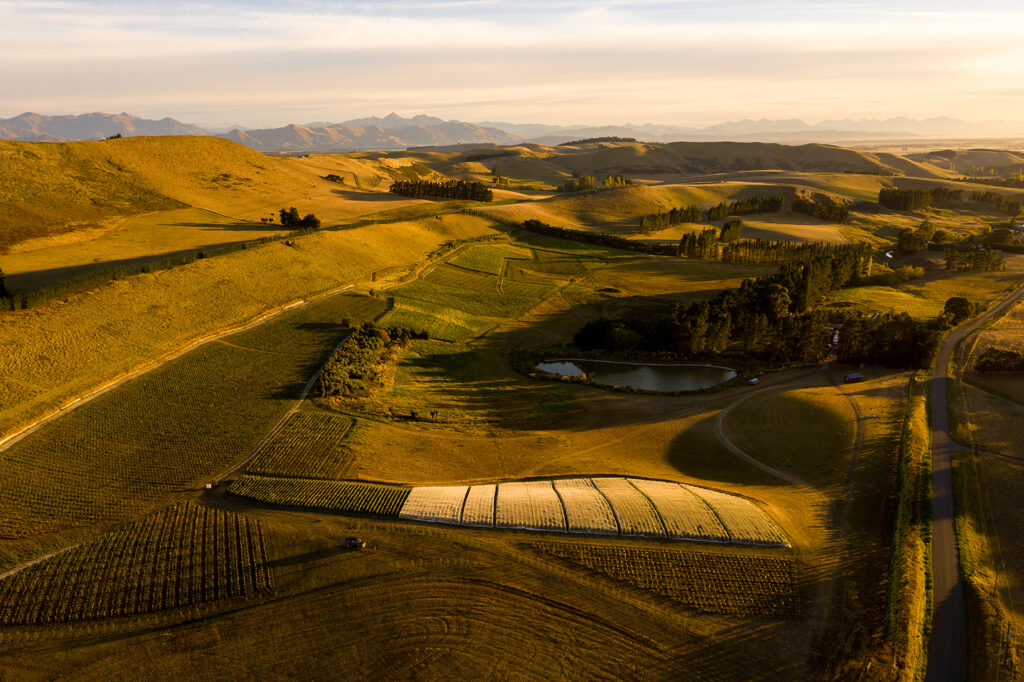
Mike and Claudia purchased the property in 2000 and planted four vineyards, Mike described these ‘as test blocks’. Two blocks of Pinot Noir and two blocks of Chardonnay. Angel Flower and Earth Smoke Pinot Noir. Angel Flower is on the north facing slope and the soil is finer and about 5% active limestone and about 20% clay. Then you hit the east-facing slope of Lion’s Tooth, and that’s more limestone and more clay – much more aggregated and friable. Across the Earth Smoke it’s quite similar soil and little variations as you go through the whole slope – 12 to 15% active limestone. Past the corner you get a little bit lower on the slope and you get to Field of Fire Chardonnay which is heavy soil over limestone. He wanted to prove that the flavour and the character of the wine comes from the soil. And he certainly did that. What we’ve done in the last two and a half years is just follow Mike’s planting plan and fill in the rest of the gaps.
All through the old nursery and the Lucerne Paddock we’ve planted Chardonnay. We’ve put a little bit of Chardonnay below Angel Flower, which will potentially be a new wine for us in the future, maybe an Angel Flower Chardonnay. The rest is extensions really, of those existing blocks.
This property is just Pinot Noir and Chardonnay. Originally it was three quarters Pinot Noir, now it’s three quarters Chardonnay, and one quarter Pinot Noir. The company has purchased a vineyard in Lowburn, the old Lowburn Ferry vineyard we call Manata. There’s the original 3 hectare slope of the Home Block, and then there’s another 7 hectare of good soil there – loess over deep silts. We’ve developed that with Pinot Noir and Chardonnay over the last three years as well.
WineFolio: As well as the soils, are the clones important?
HK: The clones are, but they are multi-clonal mixes, so they are cancelled out in terms of the differences between wines, because they’re the same clones. It’s pretty much a scientific experiment out there. I think there’s seven different clones in the Pinot, and it’s his version of Mass Selection. The orientation and the soil are the key.
With the new blocks we will explore these parcels, and I’m sure if we got something that was so different and amazing, it would get another label; or we could do a Waikari Chardonnay if something doesn’t make the grade of the original home blocks. We treat each area individually and manage those individual spots to what they need. Mike originally made the wines identical because he wanted to cancel out things like ‘picked that a week later’. That’s already been proven. So now we just have to make the best wine possible from that site in that season.
We’ll go for a walk around the vineyard, then we can come and look at some of the 2020s in barrel.
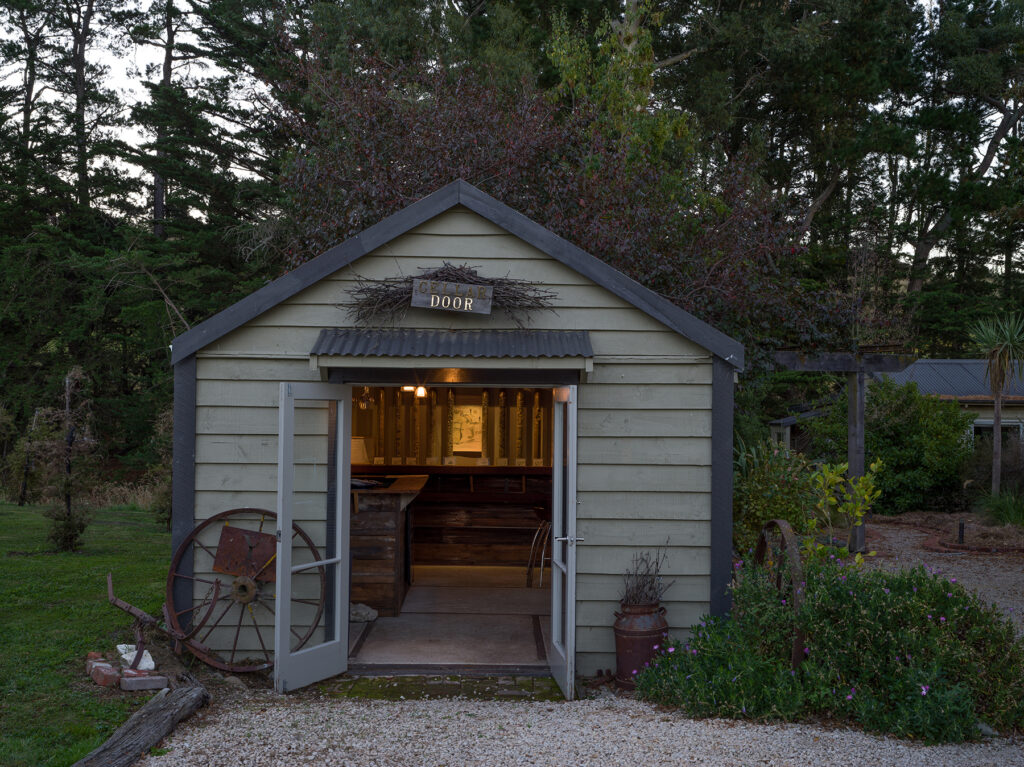
WF: what happened with the Weersings – how did it come to be taken over by Steve and Brian?
HK: Mike had some health issues, so Mike and Claudia sold PV to Brian and Steve in Spring 2017. This is a magical site in the middle of New Zealand farmland that wouldn’t have existed without Mike and Claudia. Our vision is for it to continue for generations to come, and we’re just the guardians of it at this point. It’s a total honour and privilege to live here with my family and look after this place.
WF: What’s your background and road to being at Pyramid Valley?
HK: I studied winemaking in Australia, then worked vintages around Australia and America, then came to New Zealand in 2007 to do a vintage in Hawke’s bay at Trinity Hill, and ended up never really leaving New Zealand. Did two vintages at Trinity and then in the Winter of 2008 I moved to Martinborough and I worked with Larry McKenna there for ten years. My background is more winemaking, and then this opportunity to come here and manage the development, so I can do the viticulture and the winemaking as well. A more diverse overall role, and it’s such a unique property – a once in a lifetime opportunity. We’re all just a chapter in a book in this world. Hopefully in a hundred years it’s still going strong, and one of the great vineyards of the world.
WF: How many picks would you do?
HK: We like to pick an area when we think it is in optimal ripeness so it might mean, we do two to three picks from one block or pick the whole block at once it really depends on the year and what the vineyard is telling us.
The property has been farmed biodynamically from Day One. Mike did his training, and worked for a lot of great producers, in Europe. And a lot of the great producers in Europe have been farming biodynamically since the early 90s, and that’s the way he always wanted to farm. It’s about looking after the soil, and observing your place, and being a part of it. Mike always described himself as a ‘soil farmer’ because what we’re trying to do is have a healthy, lovely, diverse soil. That then allows whatever is growing in it to be healthy, productive and give us lots of character. Then the winemaking is pretty simple.
WF: Do you think it will take a certain length of time being here, for you to get the best from what you’re doing?
HK: I guess I’ve had three years of pretty hands-on development, so it’s a little bit quicker than if I was just in the winery and not involved in the vineyard everyday. Your whole life is a journey of observing and learning. Hopefully you get better each year at what you do. And the other side is that I’ve got twenty year old vines here that are finding their way and getting deeper and more mature. New Zealand as a whole industry has got that, and I think that’s why there is an improvement of wine quality in NZ, generally as vines get older the wines have better depth and complexity. The best wines off this property are to be made in the future, that’s for sure.
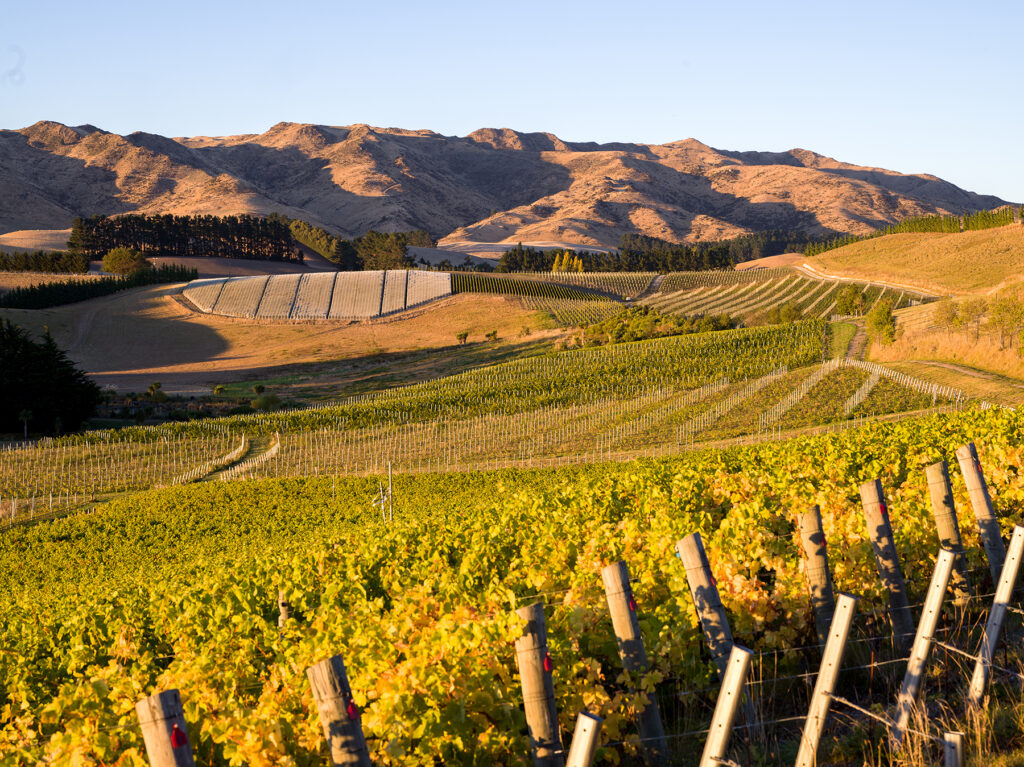
We’ve got a lot of knowledge around us as well. A lot of people have worked at Pyramid Valley over the years and are still in the industry around here. The industry is full of very generous people who share their knowledge which helps us learn faster than if we all stuck to ourselves.
WF: I hear you’ve got some new kit – including a wooden egg?
HK: Oh yes. It’s a beautiful thing, it is a piece of art. We made our old vine Waipara Springs Chardonnay in there last year. We are looking to release a single vineyard wine from that site. It’s some of the oldest Chardonnay vines in New Zealand, planted in ’83. This year we have a parcel of Sauvignon Blanc from Churton in the egg.
The new winery is still being built and it will give us more control with managing ferment temperatures and aging wine without temperature fluctuations.
WF: Do you think it’s given New Zealand wine a step up that the industry came along at the same time as a boom in technology?
HK: Technically qualified winemakers and technology has been behind the growth of new world wines, as it has produced wines that are in a consistent style from year to year. This has also made some wines which are sometimes lacking soul/personality. So I think we’ve come back around to having a balance between science and nature, particularly in the fine wine sector. You don’t have to be in control of everything to understand how things work.
Also, one of the biggest things in New Zealand winemaking is that collaborative approach. Larry created the Southern Pinot Noir Workshop thirty years ago. It is held in Hanmer Springs every January, everyone that goes takes a barrel sample that they want feedback on. The wines are tasted blind and your peers provide honest and constructive feedback. And this has really helped New Zealand Pinot Noir to get better.
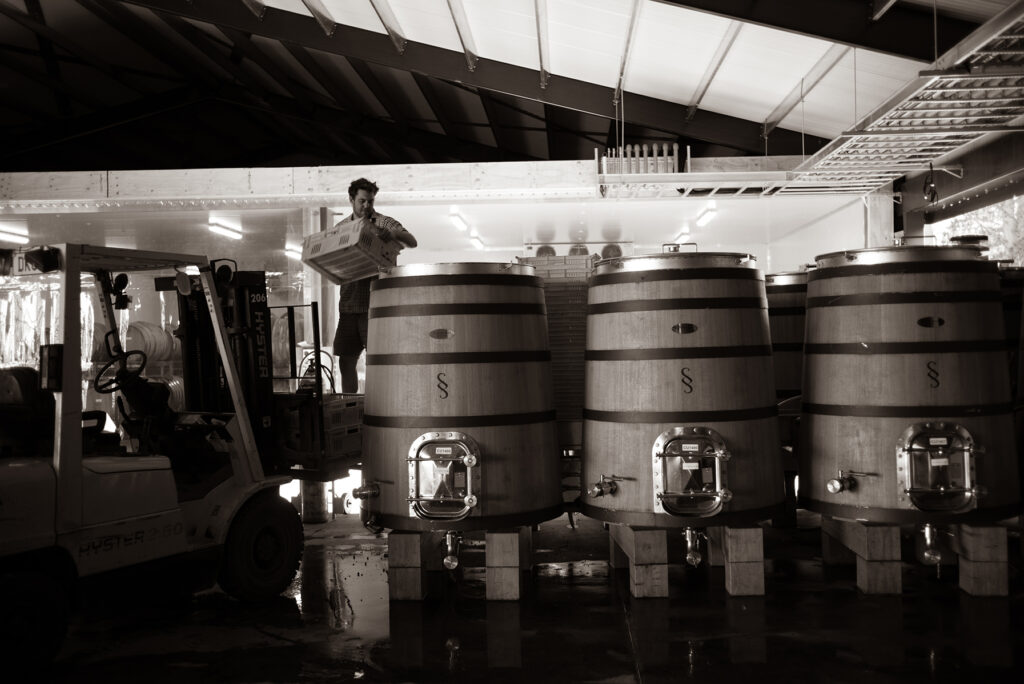
Good winemaking starts with the fruit. We’re nurturing that bit of land and growing fruit, and then we’re nurturing the ferments, and we’re hoping for a great expression of that site. That site is to do with the soil, the place, the season. And the people. The people are as big a story as everything else.
WF: My ideas in wine is all about that. You shouldn’t just get a glass of wine and think you’ll understand it all.
HK: A bottle of wine is a time capsule. Of that season, that place and the people in it. After Mike’s Memorial, Claudia put on a very nice post on Facebook basically saying that the wines are going to change. She said “Some say the wines won’t be the same, they won’t be but the site will get older, the wines will express more and this place, the place we all know as Pyramid Valley Vineyards will continue to speak it’s language. I‘m ready to listen to that.”
WF: Wasn’t it Mike who said – and apologies if I get this wrong… something like “we’re just polishing the window through which you’re looking at these wines” I thought that was awesome.
HK: Yes, he had an amazing philosophy and a wonderful way with words. I was lucky enough to have a few conversations with Mike about his wine philosophy. And we’re totally different people but we’d have the same feeling about wine, and what it is. And it’s just an expression of that place, people and time. Especially if you’re allowing it be that without manipulating it too much. Just naturally guiding it to be what it is.
For me, it’s what is your best interpretation of that place? The first year I was here it was quite daunting to take on Mike’s baby. Wondering whether you make wine the way you’ve always made wine; or do you try and guess what Mike’s decision would have been? At the end of the day, that’s the biggest mistake that you could do. All you can do is make your own decisions, and how do you let the vineyard speak?
We start to have a look at some of the wines from barrels in the winery..
HK: Field of Fire and Lion’s Tooth 2020s.. The Field of Fire is from the part of the vineyard that has the heaviest soil. This was picked in April last year, foot stomped, pressed, tank, then straight to barrel with full solids. Natural yeasts from the vineyard to ferment it. There’s still a little bit of malo to go, and it doesn’t have any sulphur in it at this stage.
WF: What do you think of that one that Dom is doing at Greystone where the ferment is actually in the vineyard?
HK: Interesting, for sure. Dealing with the variations in temperature and impact on yeasts. I think every year you have different yeast populations in the vineyard due to the climatic conditions. And for me that’s another reason to be farming as best you can, and having a healthy population of microbes out there, means you have a healthier and more complex ferment. That will lead to a more interesting expression of site. I think it’s an awesome idea.
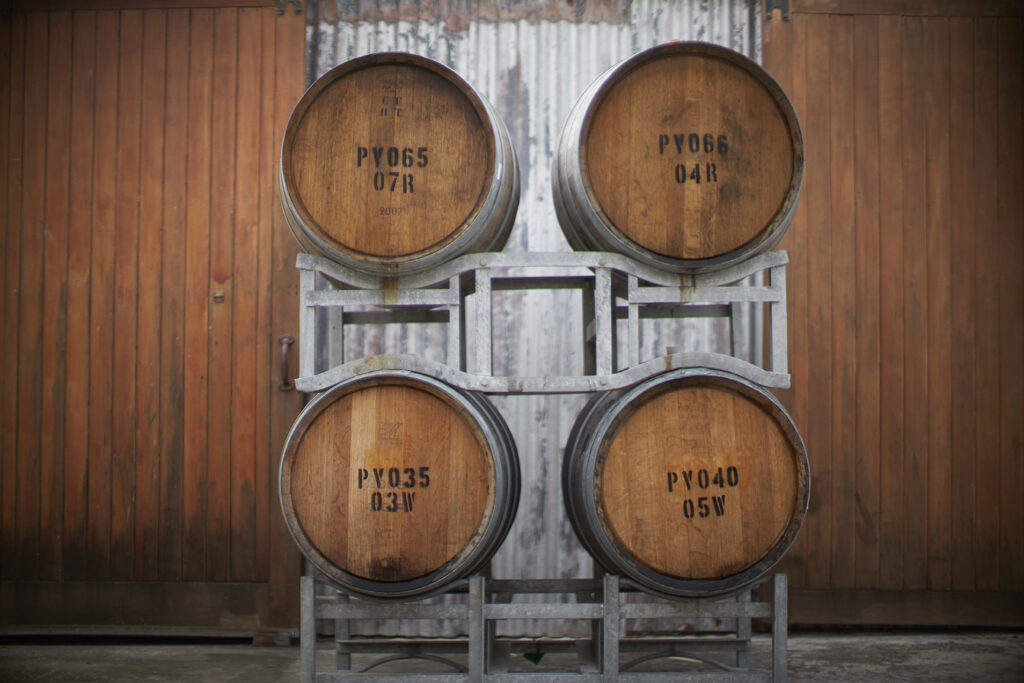
We’re lucky here because we’ve never had a commercial yeast on this property. When you observe the ferments here – some ferments from the Waipara vineyards were really foamy, and the fruit next to it from another Waipara vineyard wasn’t. And they were picked a day apart. There must be a population of yeast that is dominant in one vineyard and not the other.
Fifteen years of making wine with basic equipment. Like at Escarpment, which has a five horsepower cooling unit and that was it. No heating, so if you had a southerly through, we had cold soaks. If we had a warm day we had ferments that kicked off straightaway. That’s the way I’ve learnt to make wine, so that’s the way I still approach it now, even with the ability to have a warm room.
The vineyard has always got a salivating acidity and a piercing fruit vibrancy. Quite salty..there’s still some acid to drop out with the malo.
WF: Built to last. I reckon the limestone gives you that structure to work with.
HK: Picking half a percent earlier than historically. Although, the climate here varies quite a bit. Some years you pick at 12.5% and some at 14.5%, depending on the years. Those are the contrasts. I like to pick to retain clarity and freshness, more than too much, abundant ripeness.
WF: Lion’s Tooth is quite different though – broader, with that sweeter, apricot, mandarin peel. It’s a riper spectrum, but still nicely dry and pithy.
HK: The Lion’s Tooth site has more exposure and the vines are less vigorous because of the soil. They are physiologically ripe at the same time, but the flavour profile is riper in Lion’s Tooth than in Field of Fire. The structure – it goes across your palate and that’s the limestone I think. Where the Field of Fire has great acidity that runs down your palate.
I don’t think you can find Chardonnay anywhere else in New Zealand that are like the Chardonnays from Waikari. This area gives the balance between length and acidity, freshness and vibrancy, but then there’s still breadth and richness to them. And that is something that I’ve found in my years of making New Zealand Chardonnay – that often you get the richness and breadth, but you struggle with the length. Or you get the length and it’s tight, and lacking breadth.
WF: It’s very few occasions you find those two together. Outside of some fabulous hillsides in Burgundy!
HK: That’s what this site, and Bell Hill, can do.
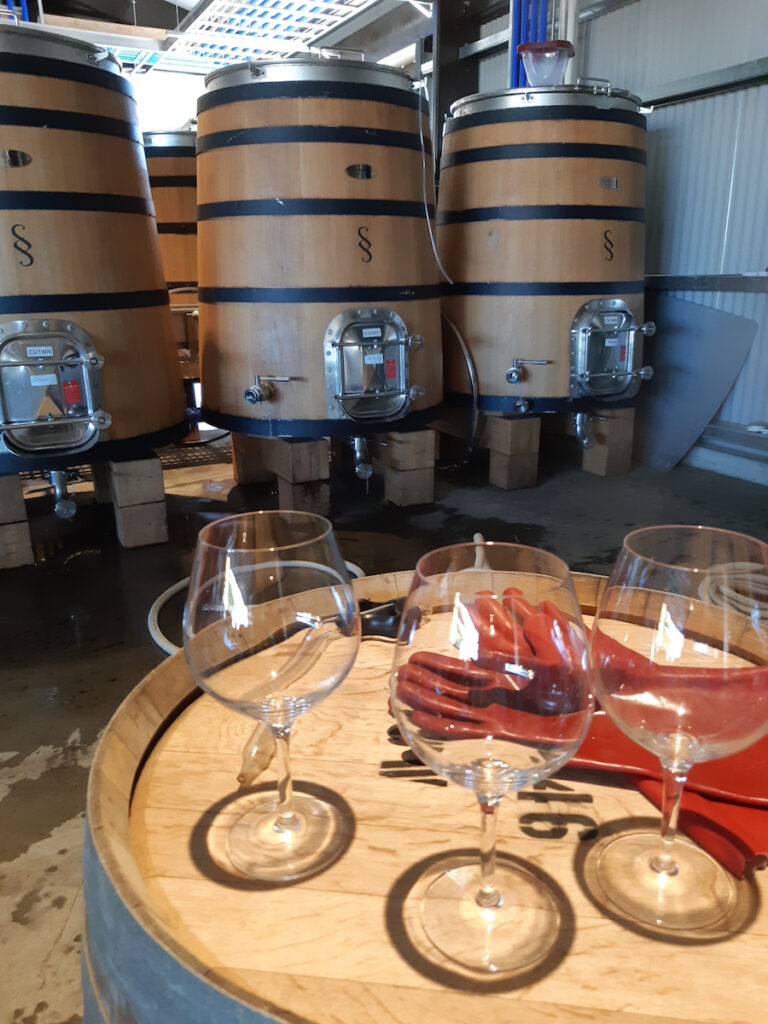
This is Angel Flower 2020. All individual ferments across two picks. Aged in a mixture of these 1400 litre cuves and some in barrels, and then just before harvest we blended the wines and went back to some barrels where they’ll stay until September. Out of the two Pinots it’s more silky and perfumed, with soft tannins and it kind of leaps out of the glass.
WF: I like the tang to it, with a blood orange, iodine and meatiness, all in one.
HK: it’s a wine that sucks you in, with the aromas and its gentleness. Not long after ferment you could probably just sit back and drink it. Straightaway. It’s just so giving and upfront, in a classy way. Very drinkable. Out of all the wines from this site, probably the most forward. It’s on north facing slopes and ten metres higher in elevation than the rest of the vineyard. The north facing orientation will give you more ripeness and fruit character and flavour but the higher elevation brings a coolness to this block. This is the first thing we pick, and it has the ripeness but it doesn’t have the same structure as Earth Smoke. It has structure, but it’s a finer structure.
WF: It’s a lovely wine. The floral, perfume is fantastic. Have the Pinots changed much over the years?
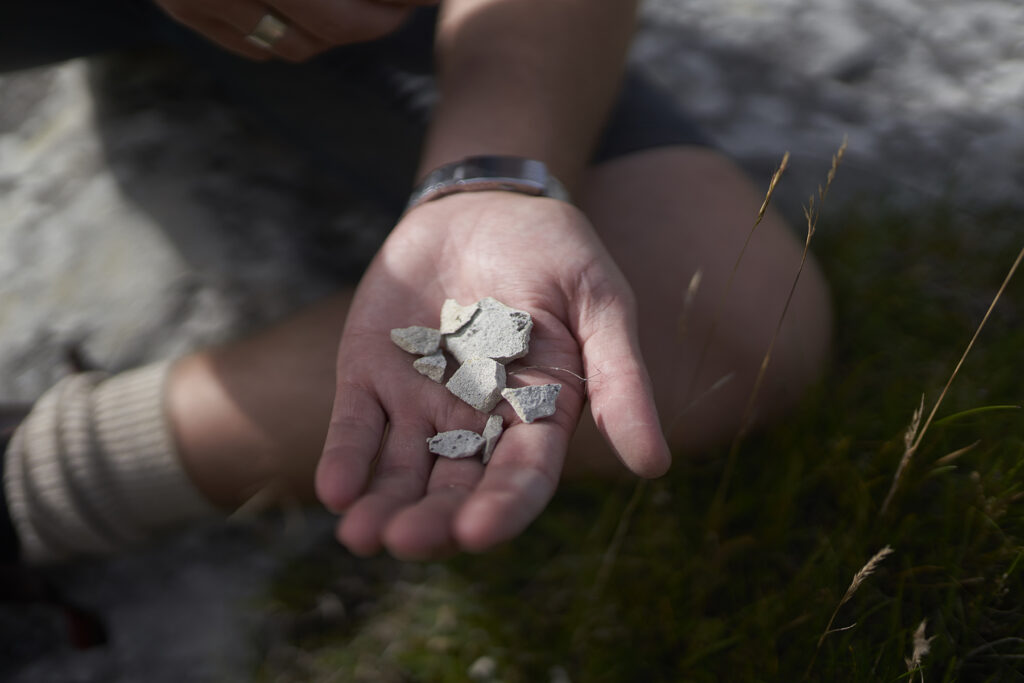
HK: Pyramid Valley has been a rollercoaster ride. For consumers, for Mike, for everybody. The Chardonnays have offered more consistency in the past. But the Pinots have been a little bit more variable. We had Mike’s Memorial in February with 80 or 90 people here, and my wife catered the event, and it was a massive weekend. Claudia brought a wine from each vintage Mike had made. So the next night after we’d tidied up we drank the part bottles of Pinot that where left, there was a thread through those wines. Take out vintage variation – there was a thread through them.
Angel Flower has always been the more ethereal and elegant expression and the Earth Smoke has been the more brooding and structured expression.
As the vines get older the wines are getting greater depth and expression of place.
WF: How did you feel about doing that weekend? You said you sat down afterwards with all the wines – did you burst into tears or something? Were you glad – not in a bad way…?
HK: I felt relief that we were able to honour Mike with the celebration he deserved. To share this place with lots of Mike’s friends, Claudia, everyone and show them what has been happening at PV since Mike and Claudia sold was very special.
WF: Did you meet some interesting people?
HK: Totally. There was a young guy who spent his teenage years coming up here every school holidays and working with Mike and Claudia. I got to chat to him and his partner. There were all these people who this place has touched. It was nice to have them here and have them see that the place is cared for.
WF: It’s also understanding that those cyclical changes are what they are and all you can do is accept that. It will break you otherwise.
HK: I was lucky enough with the ’19 vintage, that Mike came and tasted them out of barrel. He said “these are familiar to me” which was nice to hear from him. And Claudia came and tried the ‘20s and said they had a bit more maturity. She said Mike’s biggest fear when he went and developed this was that all the wines were going to taste the same.
